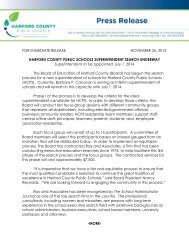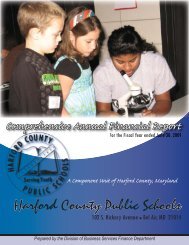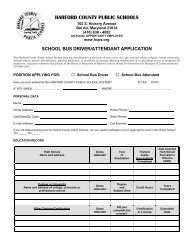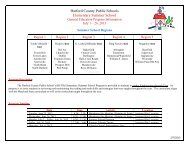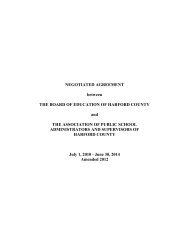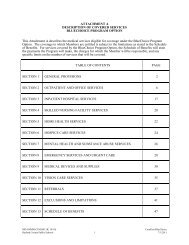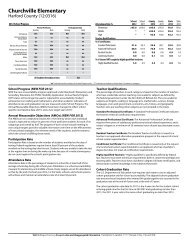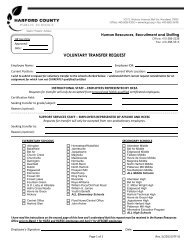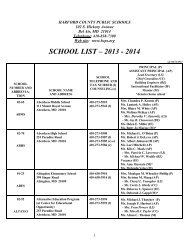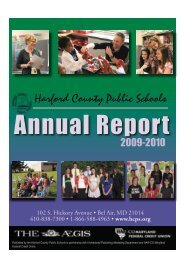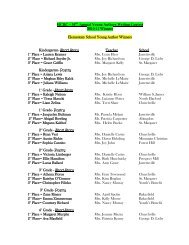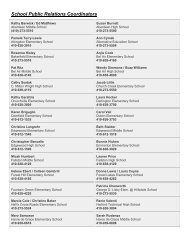Successmaker Enterprise Software Purchase - Harford County ...
Successmaker Enterprise Software Purchase - Harford County ...
Successmaker Enterprise Software Purchase - Harford County ...
You also want an ePaper? Increase the reach of your titles
YUMPU automatically turns print PDFs into web optimized ePapers that Google loves.
<strong>Harford</strong> <strong>County</strong> Public Schools – State Discretionary Grant – AYP FY 10<br />
Adequate Yearly Progress (AYP) is designed to ensure continuous improvement each year toward the goal of 100%<br />
proficiency in 2014. The State of Maryland holds schools, school systems, and the state accountable for adequate yearly<br />
progress of all children enrolled for a full academic year. If our end goal is to improve student achievement to meet AYP,<br />
then a critical intermediate goal is to determine where each of our students is in relation to the state content standards.<br />
While the logic is clear, most schools do not collect evidence of or for learning on an ongoing basis. For this process to<br />
occur schools must understand the AYP targets, have a defined process for how teachers assess for learning and<br />
monitor student progress, and determine how and what data is used to adjust instruction based on student needs.<br />
To accomplish these ends there are specific needs:<br />
1. To understand and communicate student achievement targets;<br />
2. To engage staff in analyzing state assessment data to determine whether there were any gaps between the AYP<br />
targets and their performance;<br />
3. To evaluate school processes to ensure that teachers understand the target and have aligned their teaching and<br />
assessments to those standards they are responsible for teaching ;<br />
4. To structure time to regularly examine student work to inform instruction;<br />
5. To have teachers collect and analyze formative assessment data to monitor student performance on the content<br />
standard indicators on a daily basis; and<br />
6. To keep the school focused on student achievement goals as the primary work of staff (School Improvement in<br />
Maryland, http://mdk12.org/process/index.html).<br />
The overall goal of the grant initiative is to promote maximum achievement for all students by combining the best<br />
principles of classroom management, peer assisted learning, and differentiated instruction into a comprehensive<br />
system focusing on accountability, measurable achievement, and improved access to the general education curriculum<br />
for diverse learners. Changing instructional practice is at the heart of improving learning outcomes for underserved and<br />
underachieving students. To truly improve teaching, schools need to transform their culture of practice from one that<br />
assumes that barriers to learning reside in the students to one that expects teachers to collectively assume<br />
responsibility for making sure all students learn. An emerging body of literature supports the use of learning<br />
communities and teacher collaboration as the kind of professional development that leads to such transformation<br />
(Grossman, Wineburg, & Woolworth, 2001).<br />
Building teacher capacity to implement effective instruction is critical to the success of this proposal. Professional<br />
development and on-going support provide teachers with access to the knowledge and skills essential to quality<br />
teaching instruction; data collection and analysis; problem-solving; lesson planning and implementation.<br />
On-going professional development is necessary to develop and enhance instructional practice. Opportunities for<br />
collaboration, reflection and evaluation are components of this proposal. Teacher training related to the instructional<br />
environment, an explicit cycle of instruction, increased student engagement and the use of data to monitor student<br />
progress are priorities for this initiative. Professional development addressing the specifics of building and sustaining<br />
collaborative co-teach partnerships and high performing learning teams are also an emphasis.<br />
High motivation and engagement in learning have consistently been linked to reduced dropout rates and increased<br />
levels of student success (Kushman, 2000). Teachers are challenged daily to actively involve students in the learning<br />
process. By the time students reach middle school, lack of interest in schoolwork becomes increasingly apparent in<br />
more and more students, and by high school, as dropout rates attest, too many students are not sufficiently motivated<br />
to succeed in school (Lumsden, 1994). Such considerations are imperative to improved achievement for diverse<br />
student populations.<br />
2



